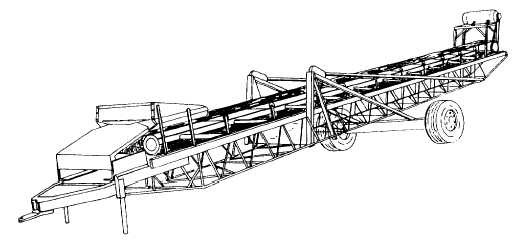Figure 6-10.-Conveyer.
rubber stripping of the wipers adjusted to just make
contact with the face of the belt. This adjustment
removes rocks from the belt, thus preventing rocks from
entering between the pulley face and inside face of the
belt.
Three factors affect the efficiency of conveyer
operation. These factors are as follows: speed, loading,
and incline.
1. Speed. Most conveyers operate at a speed of
approximately 300 feet per minute and have a capacity
of approximately 300 tons of material per hour. A
reduction in speed obviously reduces the conveyer
capacity, and an increase in speed theoretically increases
the capacity. An increase in conveyer speed may also
increase wear on the conveyer belt due to increased
slippage of the material at the loading point. An increase
in speed also increases the throw of the material at the
discharge end of the conveyer. In some cases, it may be
necessary to fit the end of the conveyer with a box or
bangboard so the material from the belt falls properly.
2. Loading. Proper loading of a belt conveyer is
mandatory for efficent operation. This includes placing
the load in a position centered on the conveyer belt. A
good practice is to load a conveyer in such a manner
that allows the material to strike the belt in the direction
of travel. When material is to be delivered from a spout
or belt to another belt from one side, a transfer box or
bangboard should be provided to facilitate proper
delivery on the belt. Loading a conveyer belt on one side
causes it to run to the opposite side of the support rollers
which results in excessive belt wear.
3. Incline. Portable conveyers can be adjusted to
operate at the various inclines required to meet job
conditions. The maximum incline is determined by the
material carried on the conveyer and varies from 12
degrees for washed gravel to 20 degrees for loose earth.
When the maximum angle is exceeded, slippage may
occur.
WASH PLANT
In many types of construction operations, it is not
necessary to have washed clean aggregates in the
finished product; however, some types of operations
require clean aggregates free of objectionable material.
The wash and screen plant (fig. 6-11) consists of a
scrubber, a vibrating screen, and a screw (sand)
dehydrator (fig. 6-12). In operation the raw material is
fed into a scrubber designed to break loose all
deleterious material. The scrubbed aggregate and wash
water are cast upon a triple deck vibrating screen for size
separation. The materials retained on the decks of the
screen are sent by individual chutes to their respective
conveyers for further disposition. The wash water and
sand are carried through the third deck into the well of
the sand dehydrator, where the undesirable products are
removed from the sand by the abrasive washing action
of the spiral conveyer and carried out into a flume by
means of the overflow water. The clean sand is carried
up and out of the water and discharged into a stockpiling
conveyer.
The capacity of the washing and screening plant is
based on the percent of sand in the deposit; for example,
each single screw washer can handle a certain amount
of material. The screen is also a factor to consider when
figuring the capacity of this plant. It is necessary to have
enough screening area to handle each gradation of
material desired.
6-11


